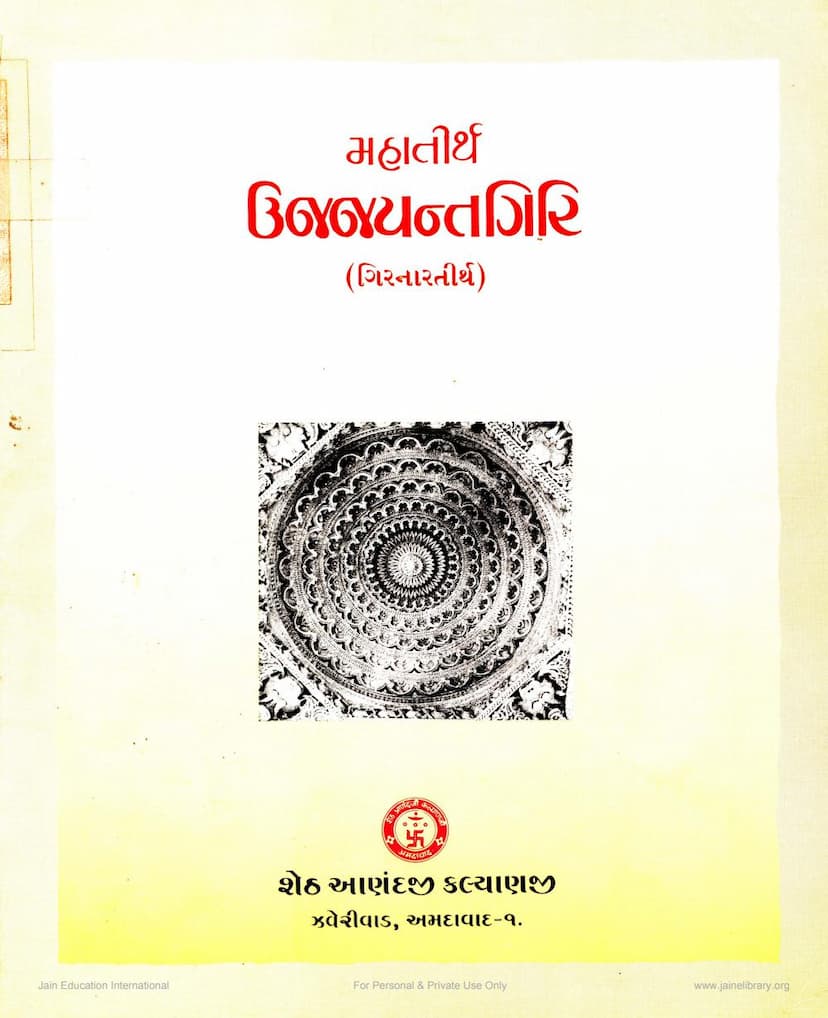Mahatirth Ujjayantgiri Girnar
Added to library: September 2, 2025

Summary
This document is a detailed historical and architectural account of the Jain temples on Urjayantgiri, commonly known as Girnar. Published by Seth Anandji Kalyanji Pedhi in 1997 (V.S. 2053), it was prepared by Prof. Madhusudan Dhanki, drawing on medieval Jain texts, inscriptions, and existing sculptural and architectural evidence.
The book serves as a guide for pilgrims and scholars, offering insights into the history, creators, and construction timelines of the temples, as well as potential solutions to current issues. The illustrations are credited to the American Institute of Indian Studies in Varanasi.
Key Highlights:
- Historical Significance: Urjayantgiri (Girnar) is a highly revered Jain pilgrimage site, considered sacred due to the initiation (diksha), enlightenment (gyan), and nirvana of Lord Neminath. The text traces the site's significance from ancient Jain Agama texts and through various medieval literary sources like "Revantgiriras," "Girnarkalp," and "Kalppradip."
- Etymology and Name Changes: The text discusses the evolution of the mountain's name from Sanskrit "Ujjayant" to Prakrit "Ujjanta," "Ujjenta," and Apabhramsa "Ujjil," eventually becoming "Urjayanta" and then adopting the name "Girnar" from the nearby city of Girinagar. It also mentions alternative names like Revat, Raivatak, and Ravayagiri.
- Temple History:
- Before the Solanki era, there were only two Jain temples: one for Lord Neminath and another for the guardian deity Ambika Devi at the summit.
- During the Solanki period, about six temples were built.
- After the Solanki era, in the 15th century, about six new temples were added, and existing ones were renovated.
- Chronology of Construction and Renovation: The book meticulously details the construction and renovation efforts from the 12th to the 15th centuries, attributing them to various ministers, merchants, and Jain community leaders. Notable figures include:
- Sajjan: The commander appointed by Jayasingh Siddharaja, who undertook the renovation of the main Neminath temple (Karnavihar) around 1129 CE.
- Vastupal and Tejpal: Prominent ministers who were instrumental in building several significant temples, including the Vastupal Vihar, Kalayantray Chaitiya, and others, between 1225-1230 CE and later.
- Narapal Sanghavi: Credited with building the Kharatarvasahi temple around 1438 CE.
- Shaangar (Shaanraj) and Bhumbha: Merchants who commissioned the Shaanswahi (Vimalnath) temple around 1453 CE.
- Poonam Kothari: Builder of the Shantijin temple around the same period.
- Other Patrons: The text also mentions contributions from various other patrons and spiritual leaders who played a role in the temple's development.
- Architectural Descriptions: The book provides detailed architectural analyses of the various temples, describing their layouts, pillars, ceilings (vitans), carvings, and sculptures. Special attention is given to the intricate artistry of the 15th-century ceilings (vitans) found in the Kharatarvasahi and other temples, highlighting their unique designs and craftsmanship.
- Specific Temples Discussed:
- Karnavihar (Neminath Temple): The oldest part dates back to Sajjan's renovation in 1129 CE.
- Vastupal Vihar: Built by Vastupal, it is noted for its architectural complexity, including representations of Ashtapad and Sammet Shikhar.
- Kalayantray Chaitiya: Built by Tejpal, later renovated by Samarsinh-Malde, and known for its symbolic representation of Neminath's three Kalyanaks.
- Kharatarvasahi: A significant temple built by Narapal Sanghavi, renowned for its exquisite 15th-century ceilings.
- Shaanswahi (Vimalnath Temple): Commissioned by Shaangar and Bhumbha, it features unique architectural elements and beautiful ceilings.
- Poonasvasahi (Shantinath Temple): Originally built by Kothari Kripalsingh, it underwent significant renovations.
- Anchalprasada (Adbhadji): Mentioned as a temple of Adinath, likely dating from the 15th century.
- Bhimkund: A water tank associated with the site.
- Gajpadkund: An important kund mentioned in Jain literature.
- Ambika Bhavana: The temple of Ambika Devi at the summit, with its history discussed from Jain and Brahmanical perspectives.
- Deviations and Inconsistencies: The book acknowledges discrepancies and debated historical points, such as the actual attribution of some temples and the influence of later renovations on the original structures. It also addresses and debunks certain popular legends or myths.
- Impact of Invasions and Renovations: The text notes the damage caused by Muslim invasions and the subsequent restorations, highlighting how these events have impacted the preservation of the original architectural features and historical records.
- Conclusion: The book concludes by emphasizing that the temples of Urjayantgiri are not just a legacy for Jains but also a significant contribution of Gujarat to Indian culture, particularly in the realm of art and architecture, showcasing the enduring spirit of Jain craftsmanship even after periods of destruction and restoration.
The text also includes a detailed index of figures (chitra-suchi) that illustrate various aspects of the temples, further aiding the reader in understanding the architectural and artistic heritage of Girnar.